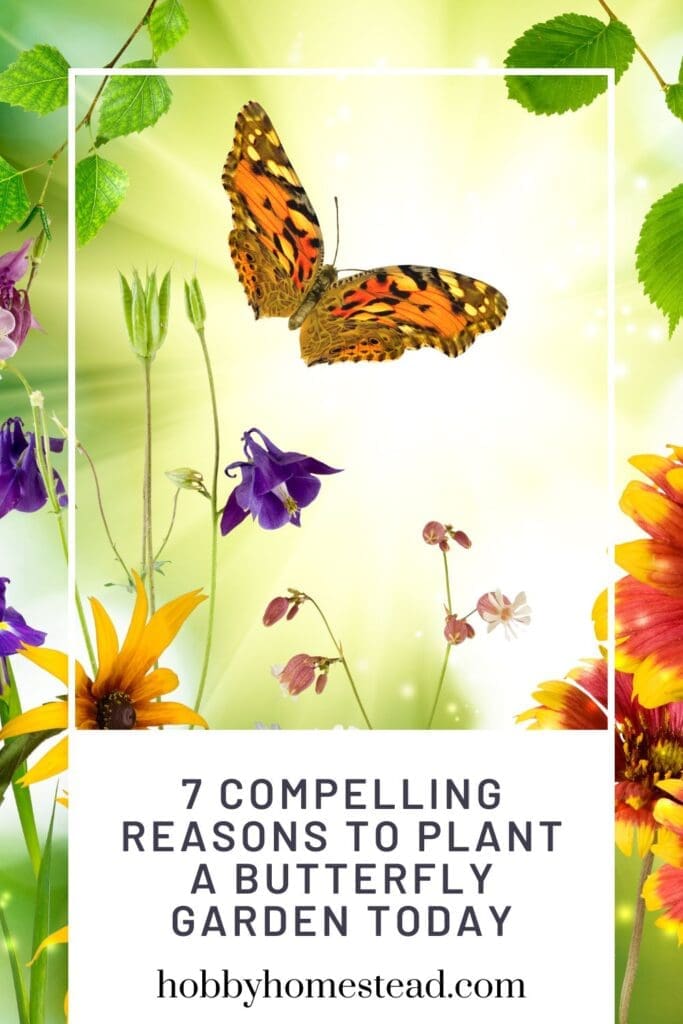Let’s explore 7 compelling reasons to plant a butterfly garden today and how you can create a productive butterfly garden full of butterfly-friendly plants. Imagine your garden teeming with vibrant blooms and alive with the fluttering wings of countless butterflies. A well-planned butterfly garden isn’t just a treat for the eyes.
It’s a lifeline for butterfly populations, especially as habitat loss and climate change threaten their survival. Creating a space for these delicate pollinators provides not only environmental benefits but also mental health boosts.
Years ago, in a few areas in my yard that are hard to get to with the lawnmower, I planted some flower seeds that are specifically designated as a “butterfly mix”. The flowers were pretty to look at and it was great seeing the butterflies. Our backyard butts up against a water area that is great for providing water to our local wildlife.

What is a butterfly garden?
A butterfly garden is a garden specifically designed to attract and support butterflies at all stages of their life cycle—egg, caterpillar (larva), pupa, and adult butterfly. These gardens feature a diverse array of butterfly-friendly plants, including nectar-rich flowers for adult butterflies and larval host plants where female butterflies can lay their eggs.
Key elements of a butterfly garden
Nectar Sources. Plants like butterfly bush, bee balm, black-eyed Susan, and purple coneflowers provide essential nectar for a variety of butterflies.
Larval Host Plants. Native plants such as common milkweed (Asclepias syriaca) and butterfly weed (Asclepias tuberosa) support caterpillars by serving as food plants.
Sunny Areas. Butterflies are cold-blooded and need warm, sunny spots to bask and fly. A butterfly garden often includes open spaces with full sun or a sunny spot to cater to this need.
Water Source. Shallow puddles, wet sand, or shallow dishes provide hydration for butterflies.
Shelter. Flowering shrubs, tall grass, and small structures like a butterfly house offer protection from bad weather and predators.
7 Compelling Reasons to Plant a Butterfly Garden Today
Butterfly gardens also contribute to the environment by supporting pollinator populations, enhancing biodiversity, and reducing the impact of climate change by promoting the use of native plants. They can transform any space whether a backyard, park, or balcony into a haven for butterflies and other beneficial insects.
1. Support Butterfly Populations
In recent years, butterfly populations, including monarch butterflies and zebra swallowtails, have faced significant challenges due to pesticide use and habitat destruction. By planting native species like common milkweed (Asclepias syriaca), butterfly weed (Asclepias tuberosa), and purple coneflowers, you can create a butterfly habitat that provides essential food sources for all life stages of these pollinators. Providing larval host plants ensures caterpillars have the specific host plants they need to grow into adult butterflies.
2. Foster a Thriving Ecosystem
A butterfly garden helps create a balanced and thriving ecosystem by supporting various pollinators and beneficial insects. By planting butterfly-friendly plants and nectar-rich flowers, you provide food sources for butterflies, bees, and other helpful insects. These creatures, in turn, pollinate your garden, ensuring the health and productivity of your plants. Butterfly gardens also attract pest predators, such as ladybugs, which help control harmful insects, reducing the need for chemical pesticides.

3. Enhance Your Existing Garden
Transform your flower garden into a butterfly-friendly space by selecting appropriate plants with bright colors that cater to the needs of different butterfly species. Adding a butterfly bush, native flowering plants, and nectar-rich flowers is a good thing for both butterflies and your existing garden. The bonus? These vibrant visitors will bring movement and beauty to your outdoor spaces. Plus they help pollinate many plants.
4. Educate and Inspire
Planting a butterfly garden is an excellent way to teach others about the fascinating life cycle of butterflies, from butterfly larvae to adult butterflies. You can involve your family in setting up a butterfly house, using a field guide to identify different butterfly species, or exploring how caterpillar’s body structures adapt to specific plants. It’s an engaging activity that blends learning with fun.
It’s easy to plan a butterfly garden with little ones from preschool through high school age.
6. Enjoy a Natural Stress Reliever
Spending time in a butterfly garden is a proven way to boost mental health. The calming effect of watching butterflies flit among nectar sources, shallow puddles, and flowering plants like ox-eye daisy or south Florida’s native species, is undeniable. Butterfly gardening offers an escape from daily stress while connecting you to nature.
7. Encourage Biodiversity
A productive butterfly garden attracts a wide variety of butterflies, each with different requirements. Female butterflies lay their eggs on larval host plants like common milkweed, ensuring the survival of individual butterfly species. To keep butterflies hydrated, include a shallow dish of wet sand or a water source in sunny areas. By accommodating these specific needs, you’re helping preserve butterfly diversity and providing an open space for them to thrive.

Tips for a Successful Butterfly Garden
- Select plants with flower nectar, bright colors, and nectar-rich flowers that appeal to butterflies.
- Include perennial plants to ensure a continuous food source throughout the growing season.
- Avoid pesticide use, which harms caterpillars and adult butterflies.
- Add a butterfly house or plant specific host plants to encourage female butterflies to lay eggs.
- Visit botanical gardens or consult the North American Butterfly Association for ideas on butterfly gardening.
By taking these small steps, your garden can become a field of dreams for butterflies, beneficial insects, and even your own sense of peace. Let your butterfly garden bloom, and watch as it transforms into a haven for nature’s most beautiful creatures.
References
Gardening Know How. Why Butterflies Matter For Our Gardens, Well-being, And Biodiversity.
Good Living. How butterflies benefit the environment.


